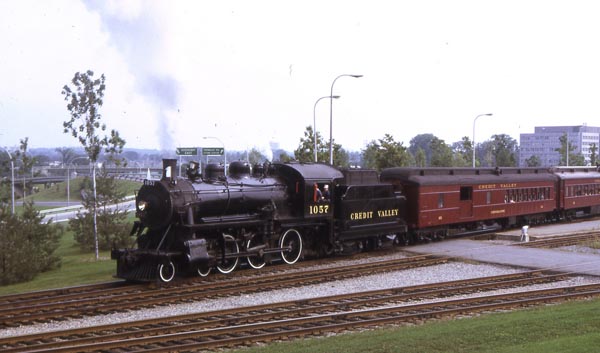Now It Can Be revealed - 1057 Runs Over a Derail At Wakefield
 Credit Valley ex-CP 4-6-0 1057at the west end of Ottawa station in the summer of 1073 4-6-0 steam locomotive 1057 began running excursions out of Ottawa to Carleton Place in July 1973. The original plan had been to run to Wakefield, Quebec but a washout forced a change of plan so that Carleton Place was used instead. By July 1974 the washout had been repaired but a turntable was not installed at Wakefield until July 11. the plan then was to run the first excursion to Wakefield, then run the locomotive backwards to Hull where it was to be turned and return backwards to Wakefield. Carleton Place was then used until the turntable at Wakefield became operative. The first excursion was a full one and there was a Canadian Pacific business car on the back containing a large number of dignitaries from CP, the National Capital Commission and the Museum of Science and Technology. The journey to Wakefield was relatively uneventful – apart from the fact that a lot of people had come out to see the steam train. At Wakefield the plan was to pull the train into the siding, uncouple the locomotive, move it on to the main line and return to Hull. We arrived at Wakefield and the train stopped on the main line just clear of the siding switch. We were all happily congratulating ourselves. We had finally achieved Wakefield and even conquered Mile Hill with a heavy train. The CP brakeman opened the switch and called the train forward. Unfortunately he had omitted to open the derail. The train moved forward and there were a couple of loud thumps and the train was stopped in emergency. Luckily the derail was of the type that was designed to derail cars coming out of the siding but not those going in. The pony truck and the first driving wheel had gone over and were on the rails. However, the locomotive stopped with the middle driver stuck squarely on top of the derail. We could move forward but any backward movement would result in a derailment – and we had a full train as well as a car of VIPs. The trick now was to move the train forward about a foot so that the derail was between the middle and last driver. The derail could then be unlocked and moved down out of the way. Easier said than done bearing in mind that the train was on an up grade and when the brakes were released it would pull the engine back. At this point I witnessed an interesting piece of management. The CP Assistant Superintendent had climbed down to see what the hold up was. He took one look at the situation, sized up the experienced locomotive crew and conductor and walked away. He had obviously decided they knew what they were doing and he could not add anything. I don’t believe many supervisors would have done that. The engineer had not worked steam for many years but by skilful handling of the train brake, independent brake and throttle he managed to move the locomotive forward about a foot so the derail could be released. There was a collective sigh of relief as we moved forward into the siding and uncoupled the locomotive. I believe this would have taken place on 1 July 1974. Duncan duFresne was the Bytown supervisor on the engine and I was one of the Bytown support crew. It was quite a way to celebrate the beginning of steam excursions to Wakefield. This is a true story. The people involved have either retired or passed on. I am sure there are other similar experiences that others have experienced in the dim and distant past. With the passage of time it is now safe to record them..Bytown Railway Society Branchline - July/August 2015 |
